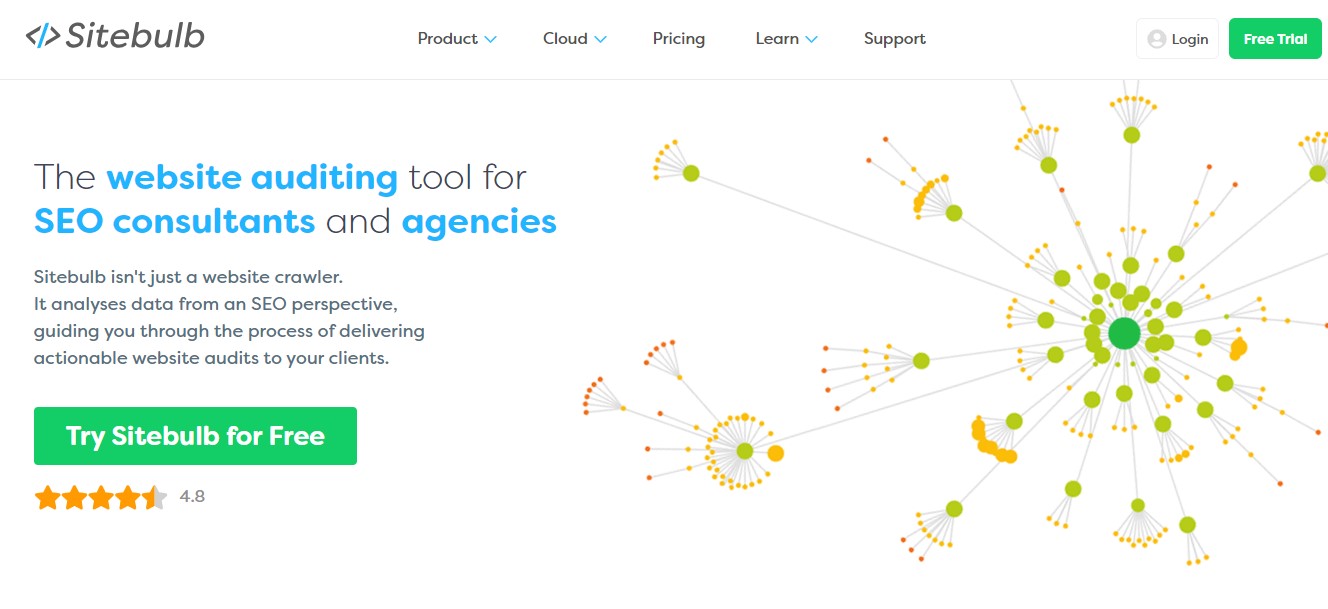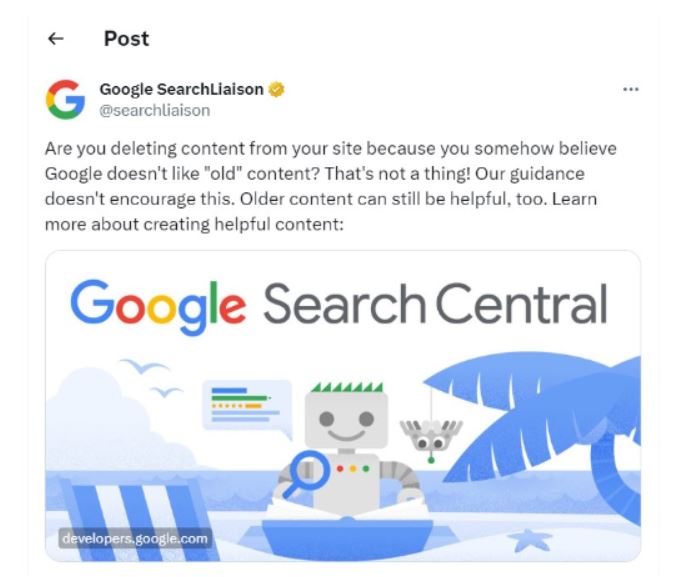Table of Contents
- Home
- »
- Content Marketing
- »
- How to remove outdated content to improve SEO
-
Anna Louise
- 8 minutes read time
How to remove outdated content to improve SEO
- Home
- »
- Content Marketing
- »
- How to remove outdated content to improve SEO
How to remove outdated content to improve SEO
Table of Contents

Search engines continuously seek fresh and valuable content to provide the best answers to users’ queries. Outdated content can mislead your audience and negatively impact your SEO efforts—so conduct regular content audits and discard or refresh stale content.
In this article, you’ll learn what outdated content is, how you can identify it, how to remove and refresh content, and SEO checks to perform after your content has been updated.
What is outdated content?
Outdated content refers to information on a website that is no longer accurate, relevant, or reflective of current trends and practices. This can include old statistics, references to events or technologies that have since evolved, or any content that doesn’t align with the current industry landscape. Keeping such content can mislead users and negatively impact a site’s credibility and search engine ranking.
TL;DR
- Regular content audits are vital for effective SEO.
- Outdated content undermines trust and rankings.
- User-centric content stands out in a saturated market.
- Pitfalls of AI-generated content: can lack authenticity.
- Competitive analysis refines strategy.
- Audit steps: identify, update/remove, monitor.
- Audits enhance credibility and user experience.
Why is it important to remove outdated content?
Poor or thin content can tarnish a website’s authority in the eyes of both the audience and search engines. When visitors encounter outdated information, their trust erodes, and their likelihood of returning diminishes.
On the SEO front, search engines aim to provide users with the best, most accurate information. Sites with dated content are less likely to rank high in search results and will be trumped by more relevant insights. Moreover, quality backlinks—a significant SEO factor—are more challenging to obtain with outdated content.
By contrast, a site rich with accurate, up-to-date, and valuable content is seen as a reliable source. It’s more likely to earn quality backlinks, favorable search engine rankings, and a loyal audience. Hence, regular content audits to remove or revive outdated content are imperative for a website owner to maintain site credibility and SEO fitness.
Market saturation and user-centric content
The digital market is saturated with an abundance of content, much of which falls short in quality. This glut makes it challenging for businesses to stand out. However, user-centric content that addresses specific needs or problems cuts through the noise.
User-focused content provides value that enhances the user’s experience and meets their expectations. Unlike generic content, user-centricity caters to the audience’s interests and queries, making it more likely to rank well in search results.
Search engines have become adept at distinguishing high-quality, user-focused content from poorly written or outdated material. To stay competitive and relevant, prioritizing the user and regularly weeding out outdated or subpar content through auditing is key.
The advent of artificial intelligence (AI) has created a surge in automated content creation. Still, AI-written content often lacks accuracy and a human touch. It’s known to churn out information that, while voluminous, may be misleading or incorrect.
Removing or upgrading generic content from your website, especially if it’s AI-generated, can give your site an edge. It not only cleanses your site of misinformation but also signals your content’s integrity to search engines.
What’s more, human oversight in content creation and updating is irreplaceable. It ensures the accuracy, relevance, and value that your audience seeks, bolstering your SEO standing in the long run.
The power of competitive content analysis
When it comes to refining your content strategy, understanding how you stack up against the competition is invaluable. A competitive content analysis offers a clear lens into what industry peers excel at or where your content might have the edge—it’s an intelligent approach to thoughtfully overhauling your strategy.
A competitive analysis entails examining keyword usage, content quality, and the freshness of the content. It also involves analyzing backlinks and the overall site structure of competitors.
Identifying gaps and capitalizing on them can significantly improve your SEO. Furthermore, understanding the content strategies that work for industry leaders can guide your content refresh and audit initiatives, ensuring your website remains compliant with SEO best practices.
Step-by-step guide to identifying and removing outdated content
Identifying and removing outdated content can reduce instances of duplicate content, improves authority by ensuring all content on the site is fresh, and sends the right signals to Google.
- What it entails: Kick things off by taking a meticulous inventory of all your site’s content.
- The tools of the trade: Platforms like Screaming Frog or Sitebulb are your best allies here. Simply pop in your site URL, and these tools can dive deep into cataloging your entire site. This action removes the need for pages and URLs to be manually checked, saving your team lots of process time. Once your insights have been gleaned, you could also use a browser extension tool such as PageImprove to quickly make changes to SEO if necessary.
- Use case: Take Company A, struggling to maintain consistent visitors. A comprehensive content catalog could spotlight a trove of outdated articles from 2015, no longer relevant to their audience or current trends.
- What it entails: Contrary to what one might think, not all old content is “bad” content.
- The decision point: An old version of an article called “Digital marketing trends of 2018” could be spruced up to reflect 2023 trends. However, a piece on “The best flip phones of 2005” might have missed the relevance boat entirely in terms of highlighting a need that no longer exists.
- Use case: Company B found an old “Office networking” guide containing dated material and a low-res image. Instead of trashing it, they updated it to a new version called “Remote work networking in the modern era,” capitalizing on current remote work trends.
- What it entails: Sometimes, you’ll find multiple pieces treading the same ground.
- The strategy: Why not merge them to create a singular, authoritative post? This approach gives your content a fresh life and can enhance SEO.
- Use case: Company C had three different blogs on “Email marketing tips.” Merging them created one go-to guide for their readers, reducing redundancy and upping the value.
- What it entails: You’ve decided what pages to keep, tweak, or toss. Now, it’s action time.
- The how-to: If you remove content, be sure to redirect visitors to pertinent pages, preserving that crucial link equity. If you’re updating or amalgamating, check all internal links and notify Google via the Search Console about your revamped material and any content removed. Check on any removal requests after some time to see whether they’re in action.
- Use case: Company D removed a discontinued product page but redirected it to a related product, guaranteeing visitors still found value and weren’t met with the dreaded “404 Page not found.”
- What it entails: Changes have ripple effects. It’s crucial to discern their impact after they’re processed.
- The tools of the trade: Google Analytics will be your expert guide, shedding light on shifts in user behavior and ranking dynamics for all your site’s pages.
- Use case: After Company E’s content overhaul, they noticed a 15% uptick in organic traffic, and a particular updated article shot up to a top 3 Google ranking.
1. Identifying outdated content
As a site owner, it’s essential to understand every web page on your site thoroughly. Periodic evaluations can highlight areas for improvement and ensure your website’s content remains aligned with current standards and audience expectations.

Source: Sitebulb
2. Deciding between updating or content removal
Not all outdated content should be deleted. The current version can sometimes be refreshed with updated information, improving your site’s SEO. In some cases, perhaps only the images must be replaced, or a link to an old file should be edited to point to a newer one. Conversely, irrelevant or inaccurate pages should be considered for removal.
3. Merging content
In some instances, consolidating multiple outdated posts into one comprehensive, updated piece can boost SEO. This step involves combining similar or related content, making sure the new piece is correct, thorough, and has an up-to-date image and outlook.
4. Implementing changes and removing outdated content using Google Search Console
Implement changes systematically to prevent any negative SEO impact. For removed pages, set up proper redirects to relevant pages to maintain link equity. For updated or merged content, confirm all internal links are updated, and re-submit URLs as a request for indexing via Google Search Console, which is Google’s tool for monitoring your site’s presence in Google Search.

Note that it takes a few weeks to index a website with fewer than 500 pages following a submitted request and two to three months for requests involving 500 to 25,000 pages.
5. Monitoring the impact for Google Search results
Track the effects of your content audit and removal on your site’s SEO. Use tools like Google Analytics to monitor changes in engagement and rankings. This data will inform future content audits and strategies.
Remove personal information from Google’s index to avoid potential legal issues
Data privacy and GDPR guidelines have changed significantly since the advent of the web, and you need to verify that your company is compliant. As long as you are the verified owner of your website, you can submit a removal request using the Google removal tool to remove a URL from Google Search results quickly. Still, additional steps are required via Google Search Console for permanent URL removal and a wipe of the cached copy. If you have queries or experience any issues with removal or wiping the cached version, contact Google directly.
Conducting a content audit isn’t just another task—it’s a pivotal strategy for your brand’s digital success. Fine-tuning your content guarantees your message is clear, valuable, and tailored to your audience. Maintaining up-to-date and relevant content helps your brand command attention. And remember, quality and relevance will always trump quantity.
Approved insights from the experts: updating versus removing content
In a social media exchange via his @SearchLiaison account, Google’s Danny Sullivan emphasized that deleting old content from a site—assuming Google disfavors “old” material—is a misconception. According to him, older content can still be valuable.
However, when questioned about outdated content with a broken URL or irrelevant data, Sullivan acknowledged that such a page might not rank effectively. While removing it could benefit the site’s overall crawlability and speed, it doesn’t necessarily enhance the site’s entire reputation.

Source: Danny Sullivan’s @SearchLiaison account
This conversation brings to light an older viewpoint from 2011 when Google, following its Panda update, suggested that low-quality content could affect the site’s overall ranking. While old content and low-quality content might overlap significantly, it’s crucial to differentiate the two. Standards for “good” content have evolved, and what was deemed acceptable a decade ago might not meet today’s standards.
In further discussions, Sullivan reiterated that Google hasn’t encouraged the removal of content purely based on age. Other Google experts, like John Mueller and Gary Illyes, also recommend enhancing content rather than deleting it when feasible.
Decoding John Mueller on lackluster and outdated content
Mueller, a Senior Search Analyst at Google, recently shed light on the complex issue of retaining or removing outdated content from Google Search.
Emphasizing the nuances of the decision, he suggested that rather than using just one metric like content age to determine a page’s worth, site owners should holistically evaluate the unique value a page brings to their website and the web in general.
For instance, while a seldom-visited “About us” page might not have changed in years, its unique informational value might make it worth retaining. Conversely, content that no longer offers unique value or relevance can be let go, echoing the sentiment of “Kondo-ing” or decluttering.
Mueller also pointed out the differentiation between news content and other content types. While old news content or original reporting often retains value due to its historical significance, it shouldn’t be equated to marketing material or documentation that might become obsolete over time.
This underlines the importance of discerning content’s intrinsic value beyond just its SEO implications. The overarching message is clear: The decision to retain or remove content should be balanced, grounded in the content’s value and alignment with the site’s broader goals.
Google Search’s helpful content update
Google’s “helpful content system” is a sophisticated system, powered by machine learning, that aims to spotlight content that genuinely meets user needs while sidelining those that fall short.
While unhelpful content might be downplayed, content and images that align with Google’s standards of relevance and engagement stand to benefit. Essentially, ranking can be leveraged by quantity and SEO, but it is the genuine quality of content that resonates with audiences.
Google’s helpful content system: what it means for every site owner
- If your site is already pushing out valuable content, relax! The system is in place to reward you.
- Noticeable user changes? This could be tied to recent system updates. Pro-tip: Self-assess and refine or remove anything that doesn’t add value.
- Curious about recovery time post-content cleanup? Expect several months. The system is vigilant, constantly monitoring both new and existing sites.
- Google periodically fine-tunes how it spots “unhelpful” content. Stay updated with “helpful content updates” on the Google Search ranking page.
Final thoughts
Our internet-savvy audiences and Google’s ever-evolving algorithms demand more than just content. They seek sharp insights, factual information, and substance with their style. With Wordbrew, you can harness the power of a platform built to optimize your content thoroughly.
We create with purpose, precision, and passion. Sign up for our hybrid-content services today and join us at the forefront of the content revolution.